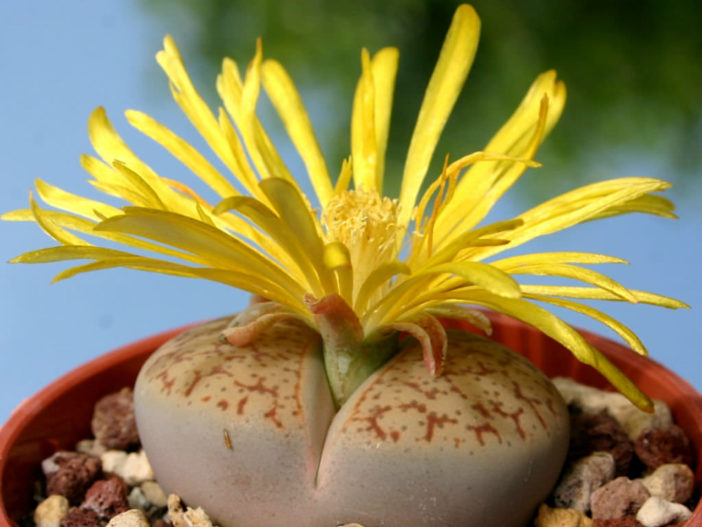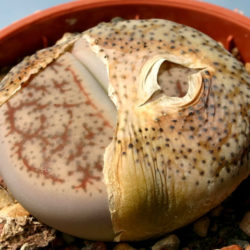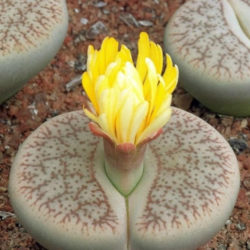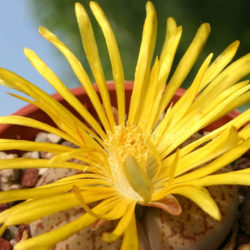Scientific Name
Lithops pseudotruncatella N.E.Br.
Common Name(s)
Truncate Living Stone
Synonym(s)
Lithops pulmoniuscula, Lithops volkii, Mesembryanthemum pseudotruncatellum
Scientific Classification
Family: Aizoaceae
Subfamily: Ruschioideae
Tribe: Ruschieae
Genus: Lithops
Description
Lithops pseudotruncatella is a dwarf succulent with bodies that consist of two pale brownish-gray leaves with olive-brown to brownish-red branched lines and spots on the upper surfaces. It grows solitary or forms small clumps. The bodies grow up to 1.6 inches (4 cm) tall. The upper surface is up to 2 inches (5 cm) long and 1.4 inches (3.5 cm) wide. The opposite leaves are separated with a deep fissure from which the new leaves and flowers emerge.
The flowers are yellow, occasionally white, up to 2 inches (5 cm) in diameter, and appear in late summer and fall.
Origin
Lithops pseudotruncatella is native to Namibia.

Hardiness
USDA hardiness zone 10a to 11b: from 30 °F (−1.1 °C) to 50 °F (+10 °C).
How to Grow and Care
These plants develop a new set of leaves every year, with new leaves emerging in the fall and growing through the winter and summer. Lithops will go dormant in late summer, and water should be severely restricted to prevent bursting leaves. The flowers appear near the end of summer or fall, first showing up as a small bud forcing its way between the leaves, and growth will begin again. It's safe to water during this period. Heading into the winter, the leaves will still grow, but you should stop watering, even as the older leaves shrivel and encase the new growth. In the spring, it's safe to begin lightly watering again as the plants start to grow again, heading toward their summer dormancy period and the emergence of new leaves in the fall.
Lithops are very slow-growing, small plants, making them ideal as houseplants (once you get the hang of their watering schedule). Older plants form attractive clumps of "pebbles" in their pots, which are highly prized. In general, plants should only be repotted if there are cultural problems (soggy soil) or the plant has outgrown its dish container, which will only happen every several years.
See more at How to Grow and Care for Lithops.
Subspecies and Varieties
Links
- Back to genus Lithops
- Succupedia: Browse succulents by Scientific Name, Common Name, Genus, Family, USDA Hardiness Zone, Origin, or cacti by Genus
Photo Gallery
Click on a photo to see a larger version.


